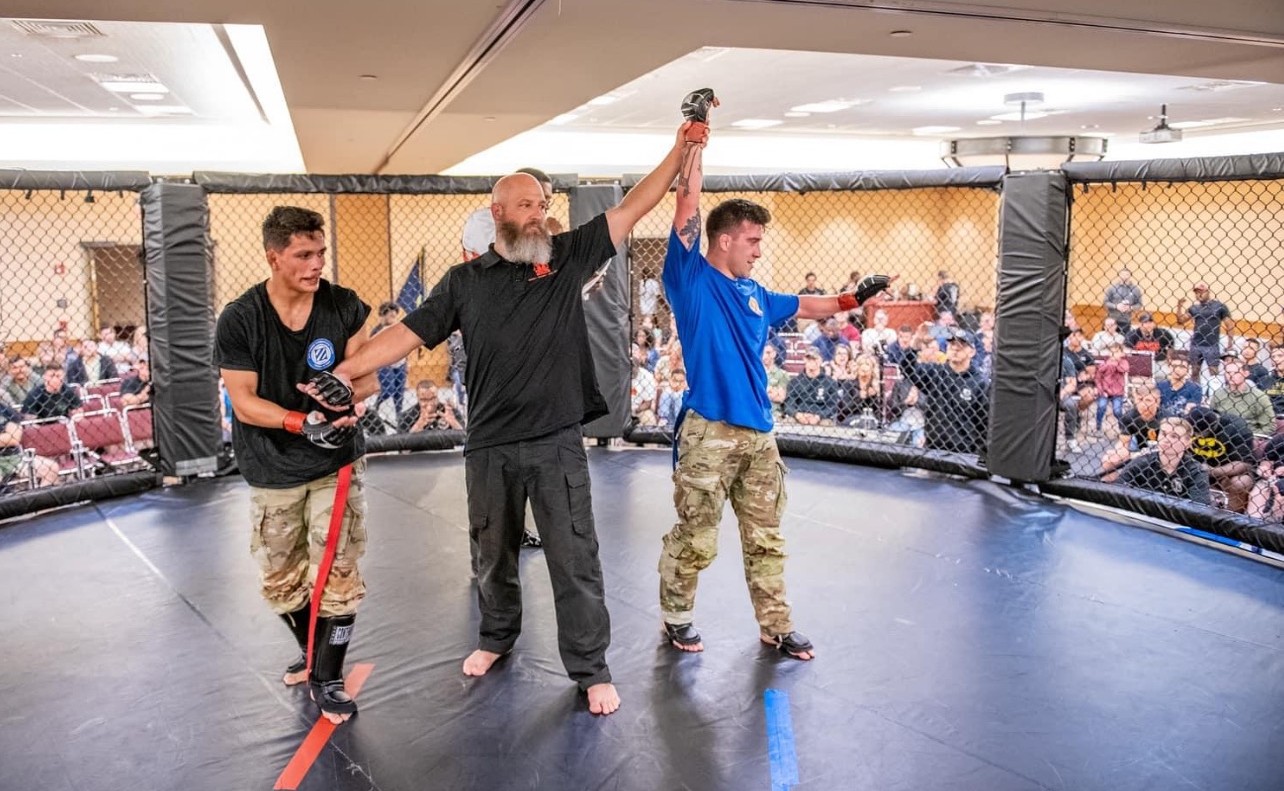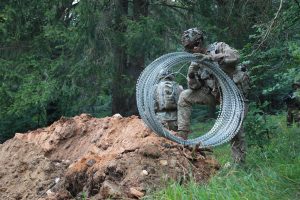Leadership at Zero Meters: Combatives for Building Lethal Teams

U.S forces close with and destroy the enemy. But how close? One kilometer, 300 meters, hand grenade range? How about close enough to hear your enemy’s last words? “Goodbye, mum”, the last words of a Ukrainian soldier as he succumbed to the wounds he sustained in hand-to-hand combat with a Russian soldier according to AFP. GoPro video posted in January 2025 on Metro UK news outlet of the encounter surfaced showing soldiers fighting with their bare hands and knives. This exchange is one of the many close-quarters engagements throughout the conflict. The war in Ukraine has highlighted the use of drones and electronic warfare. But in an era of multidomain operations, combat still transpires within arm’s reach. Unfortunately, combatives is not trained with the frequency or to the standard it should be, despite it being a core task outlined in the Warrior Ethos initiative from Maneuver Center of Excellence. We ensure our soldiers are qualified on their primary weapon system. We train and license all soldiers on a vehicle before they drive it. First Sergeant kicks doors down to make sure soldiers go to dental for a cleaning. We demonstrate care for our soldiers by ensuring they are prepared and capable to finish the fight. And yet, we fall short in our effort to train soldiers in combatives to a standard they deserve. We must prepare soldiers to engage enemies of our nation in close proximity. We can do so effectively and safely, and most importantly doing so will allow us to build resilience in our willingness to fail.
The Next Fight
Trench warfare and hand-to-hand combat have been reintroduced and proliferated in the Russo-Ukraine war. Close combat enables us to seize urban terrain and trench networks. A Ukrainian military news source in 2023 has described the soldiers in Ukraine as “face-to-face” and “fighting hand-to-hand” as they clear bunkers and trenches across the battlefield. Ukrainian soldiers engaged Russian adversaries in hand-to-hand combat when they seized Vovchansk during the recent Autum offensive of 2024 recounted by Novikov. And more recently, the gripping first-person footage of a Ukrainian soldier being overcome in hand-to-hand combat. Because of this, the U.S. Army JRTC Operations Group at Fort Johnson has seen units reintroducing battle drill 7, enter and clear a trench, and emphasizing the close fight. The close fight is still here and thus, Commanders must learn how to integrate combatives to prepare for this reality. The next fight will require multinational sustainment, innovation in technology, and contact in various domains. But the next fight will still include engagements close enough to read your enemy’s name tape.
How can I integrate Combatives?
Many units struggle to implement combatives consistently. The main issues that arise are a lack of resources, training prioritization, and safety concerns. There are resources available, but effective combatives training can be completed with no resources at all. Combatives have a negative stigma as reckless and dangerous, but when applied correctly, this is far from reality. It is the responsibility of leaders to identify and mitigate risk, rather than being deterred by it.
TC 3-25.150 is the Army’s doctrinal reference for the proper integration of combatives. This resource outlines how to assess and mitigate risk, plan and execute competitions, and integrate combatives into physical and tactical preparation. Inside your Battalion or Company, there is likely a soldier or leader who has experience in combatives or is certified under the Modern Army Combatives Program. Ask your S1 to pull who is certified. Seek them out and ask for help. Your certified trainers will be able to run formalized courses and potentially certify additional soldiers within your formation. This is an open opportunity for Company Commanders to certify their entire company up to a basic level! Combatives can still be trained even without MACP-certified personnel. Your installation Training Aid Support Center will have mats and other combatives training aids that you can utilize. Light training can also be conducted on the grass or snow with no equipment at all. Combatives drills and ground sparring can be executed in 10 to 15 minutes according to Combatives TC 3-25.150 p. 2-12 (2017) in almost any condition or location, including daily PT, unit organizational days, or skill level one training. Any STX event can include a hand-to-hand combat scenario on the objective with proper planning. Risk is always present. There are simple and practical ways to reduce it.
First, start on the ground. Most injuries result from two combatants falling in an uncontrolled manner to the ground with their combined weight on a single outstretched body part. Training can be executed on the ground and still be meaningful. Most fights are decided on the ground, so emphasizing training here is valuable. Next, limit what techniques participants can use. Striking techniques should only be incorporated when the proper protection and supervision, as outlined by TC 3-25.150, are available. Do not allow soldiers to attack small joints like wrists or ankles. Injuries to small joints happen quickly and would not necessarily incapacitate an enemy on the battlefield, so just discouraged them altogether. Pair soldiers up by like weight class. When you are conducting daily PT, training techniques, or competing pair soldiers by size. There is a suitable time to train against a bigger opponent to replicate battlefield conditions but eliminate unnecessary risk from training with opponents of vastly different size when soldiers are still learning.
In a full demonstration of the warrior ethos, the 2-87 IN BN combatives tournament was a mainstage event at the Battalion’s “Catamount Games”. This was a tremendous opportunity to demonstrate the benefits of difficult training and celebrate a tenet of soldiering in its purest form. These are all COAs and tools to conduct training, but Commanders should be empowered to ease into productive and safe hand-to-hand training even if there are limitations to resources and personnel.
Combatives is a Free Opportunity to Fail
Leaders have a fundamental responsibility to set an example in their organization. Soldiers are encouraged and empowered by leaders who put themselves in a position to fail publicly but act with humility and grace. Combatives allows leaders to demonstrate a willingness to fail but a desire to improve that soldiers and subordinate leaders can draw from and apply to their own weaknesses. Soldiers are keen observers, and they notice when leaders hide inside their comfort zone. Soldiers appreciate a leader who prioritizes the preparation of their formation over their own personal fear of failure. Combatives is a launch pad to reinforce these values.
My previous Brigade commander, Colonel Scott Wence, 2nd Brigade, 10th Mountain Division, frequently hosted and joined his Company Commanders for combatives-focused PT. He was able to unify leaders around central themes and used combatives as a mechanism to enable lethality and discipline, but also to break down the fear of failure. The adjacent Brigade commander at the time, Colonel Brian Ducote, 1st Brigade, 10th Mountain Division, competed in the 2023 All-Army Combatives Championship and defeated the previous year’s winner. He set an example of how senior leaders are not exempt from stepping up to the line and living out the Warrior Ethos. Colonel Ducote commented “combatives is unlike any other training. It prepares us for the realities of combat under immense pressure. It trains humility, trains us to recover from failure, and trains us to have a relentless mindset in the pursuit of being better tomorrow than we are today.”
Company Commanders should encourage a growth mindset amongst their lieutenants, and Platoon Leaders should be encouraged to fail forward. Do not shy away from failure. Show your soldiers humility in the struggle towards improvement and watch them chase down their own goals with the same unbridled resolve. Combatives is a training tool to share hardship. If we seize the opportunity to fail in training combatives, then we will reap the benefits of resilience that is desperately needed in large-scale combat.
Conclusion
The war in Ukraine has cast a small spotlight on the need for training in close-quarters combat. As we look forward to the next fight and the future of the Army, much of the discussion revolves around innovation and transformation in contact. While technological progress is important, in austere condition it is still destined to fail. Our teams and squads will then be charged with finishing the fight. Combatives is vital for mission success. Proficiency at the small unit level will be the ultimate difference maker in future large-scale combat operations. There are effective ways to integrate combatives which can safely and effectively improve competency and build a team around the Warrior Ethos. When your soldier fires their last round, and the enemy persists, will their preparation save them?

Author Biography
Dylan served as a Platoon Leader and Executive Officer in 2-87 IN BN, 2 BCT, 10th MTN Division where he deployed to Syria in support of Operation Inherent Resolve. Dylan is currently completing Maneuver Captains Career Course with a follow-on assignment to Joint Base Lewis-McChord. He holds a M.S in Counterterrorism and Homeland Security from American University, D.C and was a research fellow with TRADOC G-2 Foreign Military Studies Office focusing on Chinese and Russian influence in the UAE. Dylan is a lifelong wrestler. He won the 2022 and 2023 All Army Combatives Championship, Lacerda Cup and competed in the 2024 Best Ranger Competition.
Related Posts

Going Off Script, But Staying on Track: A Career Guide for Junior Leaders
Intro I walked into LTC Tomi King’s office as a new 2LT in his formation. We discussed all the normal talking points in that initial counseling – family, where I …

Fighting as an Enabler Leader
(U.S. Army Photo by Cpl. Tomarius Roberts, courtesy of DVIDS)Enablers provide capabilities to commanders that they either do not have on their own or do not have in sufficient quantity …

Defeating the Drone – From JMRC’s “Skynet Platoon”
If you can be seen, you can be killed—and a $7 drone might be all it takes. JMRC’s Skynet Platoon discuss their TTPs to defeat the drone.
